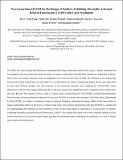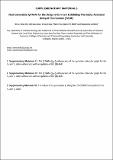Files in this item
Next generation quantum theory of atoms in molecules for the design of emitters exhibiting thermally activated delayed fluorescence with laser irradiation
Item metadata
| dc.contributor.author | Li, Zi | |
| dc.contributor.author | Yang, Yong | |
| dc.contributor.author | Xu, Tianlv | |
| dc.contributor.author | Fruchtl, Herbert | |
| dc.contributor.author | van Mourik, Tanja | |
| dc.contributor.author | Paterson, Martin J. | |
| dc.contributor.author | Kirk, Steven R. | |
| dc.contributor.author | Jenkins, Samantha | |
| dc.date.accessioned | 2022-11-17T00:38:57Z | |
| dc.date.available | 2022-11-17T00:38:57Z | |
| dc.date.issued | 2021-11-17 | |
| dc.identifier | 276432779 | |
| dc.identifier | 85a66d8b-2a0a-46f8-b921-c035f47815c0 | |
| dc.identifier | 85119072380 | |
| dc.identifier | 000719359600001 | |
| dc.identifier.citation | Li , Z , Yang , Y , Xu , T , Fruchtl , H , van Mourik , T , Paterson , M J , Kirk , S R & Jenkins , S 2021 , ' Next generation quantum theory of atoms in molecules for the design of emitters exhibiting thermally activated delayed fluorescence with laser irradiation ' , Journal of Computational Chemistry , vol. Early View . https://doi.org/10.1002/jcc.26783 | en |
| dc.identifier.issn | 0192-8651 | |
| dc.identifier.other | ORCID: /0000-0001-6647-4266/work/103510934 | |
| dc.identifier.other | ORCID: /0000-0001-7683-3293/work/103510964 | |
| dc.identifier.uri | https://hdl.handle.net/10023/26418 | |
| dc.description | The National Natural Science Foundation of China is acknowledged, project approval number: 21673071. The One Hundred Talents Foundation of Hunan Province are gratefully acknowledged for the support of S.J. and S.R.K. | en |
| dc.description.abstract | The effect of a static electric ( field and an unchirped and chirped laser pulse field on the cycl[3.3.3]azine molecule was investigated using next generation quantum theory of atoms in molecules (NG QTAIM). Despite the magnitude of the E field of the laser pulses being an order of magnitude lower than for the static E field, the variation of the energy gap between the lowest lying singlet (S1) and triplet (T1) excited states was orders of magnitude greater for the laser pulse than for the static E field. Insights into the response of the electronic structure were captured by NG QTAIM, where differences in the inverted singlet triplet gap due to the laser pulses were significant larger compared to those induced by the static E field. The response of the S1 and T1 excited states, as determined by NG QTAIM, switched discontinuously between weak and strong chemical character for the static E field. In contrast, the response to the laser pulses, determined by NG QTAIM, is to induce a continuous range of chemical character, indicating the unique ability of the laser pulses to induce polarization effects in the form of ‘mixed’ bond types. Our analysis demonstrates that NG QTAIM is a useful tool for understanding the response to laser irradiation of the lowest lying singlet S1 and triplet T1 excited states of emitters exhibiting thermally activated delayed fluorescence (TADF). The chirped laser pulse led to more frequent instances of the desired outcome of an inverted singlet triplet gap than the unchirped pulse, indicating its usefulness as a tool to design more efficient OLED devices. | |
| dc.format.extent | 2038639 | |
| dc.format.extent | 5880732 | |
| dc.language.iso | eng | |
| dc.relation.ispartof | Journal of Computational Chemistry | en |
| dc.subject | QD Chemistry | en |
| dc.subject | NDAS | en |
| dc.subject.lcc | QD | en |
| dc.title | Next generation quantum theory of atoms in molecules for the design of emitters exhibiting thermally activated delayed fluorescence with laser irradiation | en |
| dc.type | Journal article | en |
| dc.contributor.institution | University of St Andrews. EaSTCHEM | en |
| dc.contributor.institution | University of St Andrews. Centre for Research into Equality, Diversity & Inclusion | en |
| dc.contributor.institution | University of St Andrews. School of Chemistry | en |
| dc.identifier.doi | https://doi.org/10.1002/jcc.26783 | |
| dc.description.status | Peer reviewed | en |
| dc.date.embargoedUntil | 2022-11-17 |
This item appears in the following Collection(s)
Items in the St Andrews Research Repository are protected by copyright, with all rights reserved, unless otherwise indicated.


